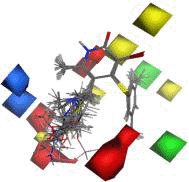化学学报 ›› 2011, Vol. 69 ›› Issue (15): 1731-1736. 上一篇 下一篇
研究论文
朱瑞新1,2, 王飞2, 刘琦*,1, 康廷国*,2
Zhu Ruixin1,2; Wang Fei2; Liu Qi*,1; Kang Tingguo*,2

C-5修饰的3-碘-4-芳氧基/芳硫基吡啶酮(IOPY/ISPY)类化合物是一类潜在的HIV-1非核苷类逆转录酶抑制剂, 特别是这类化合物因具有同时抑制野生型和突变型病毒株的特性, 而受到更加广泛的关注. 首先利用两套2D通用描述符同时构建了该类化合物的线性和非线性定量构效关系模型. 结果表明这些模型都具有较好的预测能力, 并且非线性模型较线性模型预测能力更好些. 为了更好、更形象地描述逆转录酶抑制剂的特征, 进一步结合三维定量构效关系(3D-QSAR)模型, 以及SAReport分析对该类化合物同时抑制野生型和突变型病毒株的结构特征进行了分析, 发现在对这类化合物进行结构修饰时, 需要服从如下三条理论指导原则: (1) R基团中的正负电场分布情况对化合物的活性起着关键作用|(2) R基团最好具有芳香环或芳香杂环和(3) R基团的环结构上连接的取代基不宜太多.